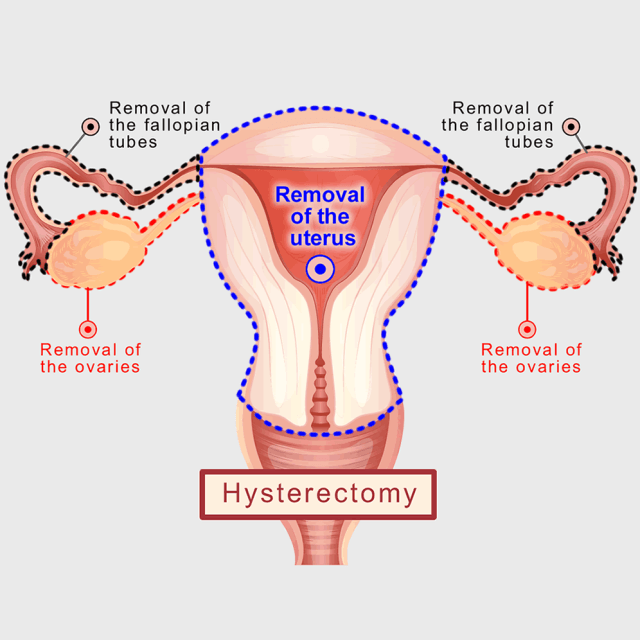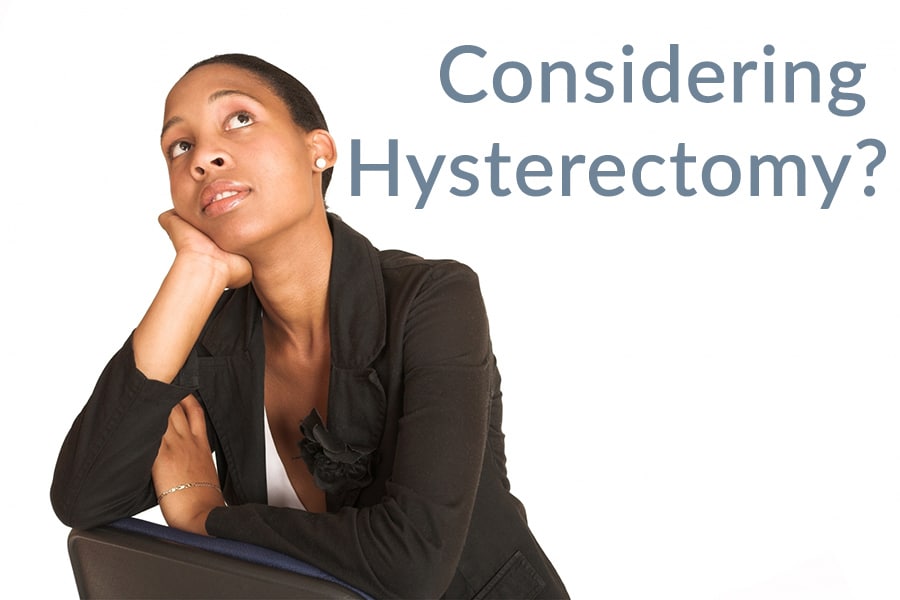For decades a surgical procedure known as a hysterectomy has widely been the standard for uterine fibroid removal and treating non-cancerous conditions in women. This is so true that over 400,000 hysterectomies are performed each year in the United States. And by the age of 60, one in every three women will have had this surgery. For some women, a hysterectomy is medically necessary. For others, there are less invasive options available they may not be aware of, but just as successful. For either case, doctors are who are quick to recommend a hysterectomy may not be aware of key research that reveals hidden health dangers of hysterectomies—including but not limited to heart disease and several other health problems.
Undergoing a hysterectomy might be the best option for your unique situation. And if so, it can be effective for fibroid removal. Hysterectomy can include all or part of a woman’s uterus and, in some cases, the fallopian tubes and ovaries. What many women might not realize, though, is how drastically this invasive fibroid surgery affects their bodies and that alternatives do exist.
One of the Most Common Surgical Procedures
Hysterectomy is the second most common gynecologic surgery after C-section. Hysterectomy is the second most common gynecologic surgery after C-section. And the most common reasons for a hysterectomy are excessive bleeding or refractory pelvic pain. Excessive bleeding can be caused by non-cancerous tumors called fibroids. These are rounded, benign muscular growths that can grow to enormous sizes and push into the uterine cavity. When fibroids push on the inside lining of the uterus, they can cause the release of blood at unexpected times, and often, the amount is excessive and can lead to anemia. In addition to heavy bleeding, a woman will also likely experience a variety of other telltale symptoms, such as the ones listed below.
Common Fibroid Symptoms
- Painful periods, debilitating cramps, pelvic pain, and pressure
- Painful intercourse
- Fatigue and weakness
- Bloating or swelling in the lower abdomen
- Back or leg pain
- Urinary frequency
- Constipation, diarrhea, and rectal discomfort
A hysterectomy can be performed through the vagina, abdomen, or laparoscopically, and there is almost no chance of fibroids returning after this procedure. Doctors may recommend one of three types of hysterectomies.
- Partial hysterectomy — Only part of the uterus and possibly the ovaries are removed. The cervix remains intact.
- Total hysterectomy — The uterus and cervix are removed. The fallopian tubes and ovaries will likely be removed.
- Radical hysterectomy — The uterus, cervix, and its surrounding tissue are removed, including the upper part of the vagina. The fallopian tubes and ovaries may or may not be removed.
While having this surgery sounds good in theory, there are a litany of risks.

Hysterectomy Risks: Very Concerning Numbers
Like any surgical procedure, there are risks involved with having a hysterectomy. According to the National Library of Medicine, 29 relevant studies evaluating the long-term impact of a hysterectomy were conducted between 2005 and December 2020. A quick review showed that this procedure may increase the risk of cardiovascular events, certain cancers, the need for further surgery, early ovarian failure and menopause, depression, and other outcomes.
The study most widely cited among medical journals is Laughlin-Tommaso et al. 2017, which states women who underwent a hysterectomy at age 35 years had a 4.6-fold increased risk of congestive heart failure and a 2.5-fold increased risk of coronary artery disease. Her team of researchers identified 2,094 women who underwent a hysterectomy with ovarian conservation (the ovaries were saved) between 1980 and 2002 and found they were more likely to develop hyperlipidemia, hypertension, obesity, cardiac arrhythmias, and coronary artery disease.
The Mayo Clinic noted that Dr. Laughlin-Tommaso’s findings were in younger women. Those aged 50 and older didn’t appear to have an increased risk of cardiovascular disease and metabolic conditions. That said, previous research from the Nurses’ Health Study published in 2009 had shown a 17% increased risk of coronary heart disease after hysterectomy with removal of ovaries, compared with hysterectomy leaving the ovaries in place. This new study shows that women who underwent a hysterectomy had a:
- 14% increased risk of high blood fat levels
- 13% increased risk of high blood pressure
- 18% increased risk of obesity
- 17% increased risk of irregular heartbeats, and
- 33% increased risk of coronary artery disease
The Mayo Clinic added that researchers say Laughlin-Tommaso’s study overcomes several limitations of prior studies, including the fact that they could detect more cardiovascular disease events compared with other studies where follow-up was limited to 10 or fewer years.

Additional Hysterectomy Risks
- Excessive bleeding that may require transfusion or delayed healing.
- Infection of the incision or the top of the vagina
- Wound separation can occur, especially in obese patients, smokers, or people with diabetes.
- General anesthesia is a risk during a hysterectomy due to the stress it places on the heart. There is also a risk of lung infection due to a tube being inserted into your airway.
- Blood clots forming in the legs or pelvis.
- Bladder, ureter, and bowel complications can occur because of the closeness of these structures to the uterus and cervix. A catheter is placed in the bladder before the procedure to help protect it and is removed soon after surgery. But that adds discomfort and risk of a urinary tract infection.
- Reduced blood supply can result in an earlier-than-expected menopause.
- Sexual dysfunction because of low hormones or due to the fact that the nerves to the upper vagina and cervix were removed is another potential undesirable consequence.
Alternatives to Hysterectomy for Fibroid Removal
While a hysterectomy may be necessary for some women, others could be candidates for a minimally invasive treatment option called uterine fibroid embolization (UFE). UFE can be just as effective as a hysterectomy while providing additional benefits, but many women are not aware of it.
During a UFE procedure, a tiny tube is fed through nonessential blood vessels leading to the fibroids, and the blood flow to all the fibroids is blocked from the inside. With blood flow having been cut off, fibroids shrink and die. Thus, the patient will experience a fast reduction in life altering fibroid symptoms.
UFE has been proven to significantly reduce heavy menstrual bleeding, relieve uterine pain, and improve energy levels. Patients can go home the same day, and the recovery time is usually 7-10 days—much less than a hysterectomy.

Advantages of UFE at Fibroid Institute
- Covered by most major medical insurance
- Over 90% of patients see dramatic improvement in symptoms
- Avoid side effects of pharmaceutical hormone therapies
- No incisions, which means no surgical scarring
- In-office procedure instead of hospital stay
- Procedure typically completed in under an hour
- All fibroids may be treated at the same time
- Doctors are 100% dedicated to fibroids treatment and UFE
- Mobile number given to every UFE patient to contact her doctor directly
Because OB/GYNs do not perform UFE, many are unaware of the benefits of the treatment, including the success rate and the fact that many women could be candidates for the treatment. An interventional radiologist is typically the best source for information about UFE.
Don’t Commit to a Hysterectomy Until You Learn More
A hysterectomy removes all or part of a woman’s uterus and, in some cases, the fallopian tubes and ovaries. And it can be a beneficial procedure for some women. But don’t commit to a hysterectomy until you understand all the potential long-term health risks and speak with our team at Fibroid Institute Texas. Believe it or not, there are options to surgery that your doctor may not have told you. This includes UFE which avoids the risks commonly associated with surgery.
Our fibroid doctors are board-certified interventional radiologists and experts who are passionate about helping women become #FibroidFree. Fibroid Institute provides highly experienced UFE specialists, 100% focused on fibroid issues.
With each UFE procedure, patients quickly realize they don’t have to be limited by fibroid symptoms or lengthy recovery times. Are you a candidate? Request a free 10-15 minute phone screening find out. After the screening, if you qualify for UFE, you can schedule your onsite or telehealth consultation. Most major medical insurance providers cover the cost of UFE.
We are dedicated to helping you become #FibroidFree. Get started now with Fibroid Institute Dallas at 214-838-6440 or with Fibroid Institute Houston at 713-903-3733 or complete the form below.
Fibroid Institute Texas serves the Dallas and Houston areas including Addison, Carrollton, Plano, Frisco, McKinney, Allen, Fort Worth, Grand Prairie, HEB, Arlington, Hutchins, Irving, Duncanville, DeSoto, Cedar Hill, Lancaster, Cockrell Hill, Highland Park, University Park, Park Cities, Garland, Mesquite, Richardson, Dallas, Sherman, Houston, Sugar Land, Katy, Webster, The Woodlands, Universal City, Spring, Kingwood, Stafford, Conroe, Texas City, Cypress, League City, Bellaire, and more.
This information is not a substitute for professional medical advice. Prior to starting any new treatment or if you have questions regarding a medical condition, always seek the advice of your doctor or other qualified health provider.
*Patient stories are true. Names and/or photos may be changed to protect patient confidentiality.

